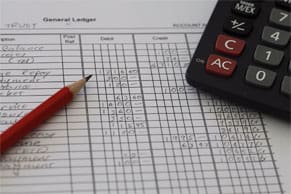When companies do business with each other, they often use credit, rather than paying at the time of sale. In these cases, the selling company informally extends credit to the buyer based on their working relationship and delivers its products or services with the expectation of getting paid at a later date. When the buyer receives the invoice, it begins its accounts payable (AP) process. Until that process culminates in payment, the obligation for those goods and services is recorded as a liability on the buyer’s balance sheet in an account, or group of accounts, called AP. Businesses that use the accrual method of accounting have to understand what AP and the AP process are all about.
What Are Accounts Payable?
A company’s accounts payable represents amounts owed to others for goods and services purchased on credit. They are short-term liabilities that arise from the normal course of business, such as invoices owed to utilities and suppliers. AP departments are responsible for processing expense reports and invoices and for ensuring payments are made. AP is a key line item in the current liabilities section of an organization’s balance sheet. In the realm of accounting, accounts payable is the direct counterpart of accounts receivable (AR).
Accounts Payable vs. Trade Payables
Some describe accounts and trade payables as the same thing. Technically, though, trade payables are a subset of AP in that they describe outstanding amounts due to suppliers for inventory delivered to a business.
Accounts Payable vs. Accounts Receivable
Where AP represents the amount that a business owes in the form of short-term obligations to creditors and suppliers, AR is the funds it is due to receive from creditors, such as customers, distributors and partners.
Key Takeaways
- Accounts payable represents an organization’s obligations for goods and services purchased on account.
- Accounts payable and trade payables are current liabilities because they are expected to be settled in the short term.
- AP teams are responsible for processing invoices, purchase orders and payment in accordance with established policies and workflows.
- Total accounts payable is a key line item on balance sheets and within a general ledger.
Accounts Payable Explained
AP represents a significant portion of a business’ liabilities. Failure to follow best practices when managing accounts payable can be costly. Some supplier agreements include escalating fees for late payment of invoices. Falling behind may lead to delays in receiving goods and services from suppliers. Habitually paying invoices late also often signals cash flow issues.
How to Record Accounts Payable
When a finance team receives, say, an expense report from an employee or an original invoice or purchase order for goods and services, it is entered in the general ledger (GL) as a payable. Once an authorized official approves the expense and payment is issued per the payment terms of the invoice (such as Net 30 or Net 60 days), the accounting team records it as paid. The AP workflow follows these six steps:
-
Receive the Invoice
Vendors send invoices to request payment for goods or services that have been delivered. The invoice shows the terms of the sale and the payment terms. Invoices are received in various forms, such as by mail, email or digitally into an automated workflow.
-
Review and Approve the Invoice
The invoice should be reviewed to ensure that all components are correct, including the description of the goods or services, their unit costs, the total cost and the payment terms. It’s also important to verify that the goods or services have been authorized and delivered, which is often accomplished by matching the invoice to a purchase order, bill of materials or shipping documents. In addition, the appropriate person should approve the invoice. This person is often the department manager who ordered the items, but it can also be an AP clerk for amounts up to an agreed-on threshold. Invoices are routed by hand, email or automated workflow for approvals and then make their way back to the AP department.
-
Enter the Invoice Into the Accounting System
The invoice details are entered in the accounting system, usually in the AP module. This is done manually or automatically (using optical character recognition, or OCR). The invoice is correlated with vendor profiles that have been previously set up within the AP system. These profiles include all contact and payment details, such as banking information and discount policies, like early payment incentives. Once the invoice has been entered into the accounting system, it is called an “open invoice” or “open payable,” meaning it is awaiting payment.
-
Debit the Expense or Asset Account
An important step in the AP processing is called account coding. This means assigning every invoice to the proper GL account based on the nature of the items purchased. The assignment is made using the company’s chart of accounts. This code is the debit side of the journal entry that records the accounts payable. The debit will be for an expense, such as electricity and advertising, or an asset, such as raw materials inventory. Sometimes the coding is assigned before the invoice is routed for approval so that approving managers can see how the item is being classified.
-
Credit the Accounts Payable Account
Credits increase AP. The credit side of the journal entry that records the invoice is made in the AP GL account. This account is where all open invoices sit until they are paid. Sometimes companies use multiple GL accounts to separate different types of AP, like taxes. A list of all the individual credits for each invoice is commonly called the AP journal. The individual credit balances for each vendor can also be separated by due date, called an AP aging report. Reviewing these AP reports helps ensure that amounts owed are not missed and are paid in a timely fashion.
-
Payment of Invoice
The invoice is paid only after all the prior steps have been completed satisfactorily. Payment is made via paper or electronic checks, company credit cards or electronic transfers, such as automated clearing house (ACH) or digital wallet. The payment triggers a second journal entry that debits the payable account to remove the balance and an offsetting credit to reduce cash.
Types of Accounts Payable
Businesses have many categories of payables and liabilities, so it’s helpful to understand which ones are considered AP and which ones are not. AP meets several criteria. First, they are amounts owed to others for which an invoice has been received. Second, they are short-term debts, meaning they are expected to be paid within one year. Third, they are processed through an AP system. Last, they are included in the current liabilities section of a company’s balance sheet. In general, there are four types of accounts payable: trade payable, nontrade payables, loans payable and taxes payable.
However, “payable” is a general accounting term that refers to any amount owed but is often misused in casual conversation. While all payables are liabilities, not all payables are considered AP because they don’t meet the AP criteria, such as payables with long-term due dates. Even among current liabilities, not all are considered AP due to their particular characteristics, such as wages payable or deferred income, which are both processed outside of AP systems. Accrued expenses are another current liability that is not part of AP. By its definition, accrued expenses are amounts owed by a company that have built up over time but have not been invoiced, like quarterly loan interest. Another consideration when classifying a payable as AP is whether it is part of the normal course of business. A payable for a legal settlement, for example, would not be a typical part of a company’s operations, so it would not be included in AP.
-
Trade Payables
Trade payables refer to moneys owed to suppliers for inventory-related goods. They are often recorded in a designated account within AP. This is helpful when accounting for inventory valuation. Invoices for flour and sugar would be considered trade payables for a bakery.
-
Expense Payables
Most AP falls in this category. Expense payables relate to any nontrade good or service, such as advertising, insurance, office supplies, gasoline, utilities and employee travel and entertainment. The hypothetical bakery records an expense payable for cleaning services that have been received and invoiced but not yet paid.
-
Rebates and Discounts Payable
Rebates and discounts payable are amounts owed to outside parties because of overpayment. They often arise when a customer has earned lower rates because they reached a spending threshold or met special criteria. The retroactive rate adjustment results in a reduction in revenue and a payable back to the customer. For example, when an auto insurance company’s policyholder attains “safe driver” status, the insurance company may owe a rebate for previously paid full-rate premiums. Businesses that use rebates and discounts frequently account for the payables separately, but some smaller businesses may process these payments through AP.
-
Notes Payable
A note payable is a more formal version of AP. It is an obligation in the form of a written promissory note, a type of loan payable. Many notes payable arise from restructuring trade payables. Only the short-term portion of notes payable may be included as part of AP.
-
Dividends Payable
Dividends are distributions of income from a company to its shareholders. A company records a dividend payable on its books after it declares the dividend and before it pays them. The official declaration serves as the “invoice” in these cases. Dividends payable are usually short-term, especially for companies that distribute dividends on a quarterly basis. Dividends payable are tracked in a separate GL account but can be combined with other AP on the balance sheet.
-
Taxes Payable
Businesses have a liability for several types of taxes, including sales tax and income tax, owed to federal, state and local tax authorities. The balance of these obligations that are due within the year are considered current liabilities. Although the government doesn’t send an invoice, the amounts owed are implied and included as a separate type of account payable.
Accounts Payable Examples
Virtually all businesses have expenses. Restaurants must order food inventory from any number of suppliers. Typical operational costs include rent, utilities, and insurance. A medical practice may pay a specialized cleaning company and expend funds on leased equipment and legal counsel. Essentially, outside of payroll, if your company receives and pays an invoice, that’s AP.
Consider Greenie Bakery, a hypothetical small café that sells baked goods and coffee. Greenie purchased $1,000 of flour on credit from a wholesaler, GatorGirl Inc. The flour was delivered in early February. At the end of the month, Greenie received an invoice from GatorGirl, verified that it was correct and began the AP process. Greenie records the following two journal entries to reflect this transaction:
Step 1: When the invoice was received:
| Date | Account | Debit | Credit |
|---|---|---|---|
| 2/28/2023 | Raw Materials - flour | $1,000 | |
| Accounts Payable - GatorGirl Inv# 9876 | $1,000 | ||
| To increase flour inventory and increase accounts payable | |||
Step 2: When the invoice was paid:
| Date | Account | Debit | Credit |
|---|---|---|---|
| 3/15/2023 | Accounts Payable - GatorGirl Inv# 9876 | $1,000 | |
| Cash | $1,000 | ||
| To eliminate account payable and reduce cash for payment | |||
Accounts Payable (AP) Team
Depending on the size of an organization, an AP team could comprise one or many people. In cases where a team consists of several employees, a manager is usually responsible for keeping the department running smoothly. AP team members must have strong organizational, analytical and communication skills; be detail-oriented; and work well with computers, including accounts payable automation software.
Accounts Payable Roles and Responsibilities
| Role | Responsibilities | Skills Required |
|---|---|---|
| AP Manager | Strategic planning, staff training, vendor negotiations, process improvements, liaison with other departments and auditors. | Leadership, strategic thinking, negotiation, communication, accounting knowledge, analytical skills. |
| AP Supervisor/ Lead | Overseeing invoice processing, managing payment timelines, workload distribution, and issue resolution. | Supervisory skills, problem-solving, organizational, time management, attention to detail. |
| AP Clerk/ Specialist | Invoice entry, verification of payment terms, maintaining vendor information, preparing payment batches, reconciling statements. | Data entry, proficiency with AP software, numerical accuracy, understanding of accounting principles. |
| AP Analyst | Generating reports, spend analysis, identifying cost-saving opportunities, assisting in closing processes. | Analytical skills, advanced Excel, data analysis, report writing, critical thinking. |
| Data Entry Clerk | Accurate data input, preliminary invoice checks, digitizing paper invoices. | Fast typing, attention to detail, basic accounting knowledge, familiarity with data entry software. |
| Vendor Relations | Resolving invoice discrepancies, negotiating payment terms, maintaining vendor relationships. | Interpersonal skills, communication, negotiation, problem-solving, customer service oriented. |
| Procurement Liaison | Coordinating with procurement for PO matching, verifying receipt of goods/services, ensuring policy compliance. | Communication, coordination, attention to detail, understanding of procurement and AP processes. |
| AP Compliance Officer | Auditing transactions, maintaining documentation for audits, regulatory compliance. | Knowledge of compliance laws and regulations, auditing, attention to detail, organization. |
| Technology Specialist | Managing AP software and systems, implementing automation tools, training on new technologies. | IT skills, knowledge of AP systems, training abilities, troubleshooting, project management. |
| Treasury Coordinator | Forecasting cash requirements, ensuring liquidity for obligations, optimizing payment timing for cash flow management. | Financial forecasting, cash management, analytical skills, strategic planning. |
Automating Accounts Payable
AP automation converts the entire invoice-to-payment process to a digital environment, including receiving and entering invoices, GL coding, approval routing and payment. E-invoicing eliminates paper invoices and digital OCR capture scans the invoice data into the AP system, eliminating the need for manual data entry and paper storage. The invoices can be automatically matched with purchase orders and supporting receiving information, which are also digitized. Automating these steps supplants manual, repetitive and tedious tasks. AP automation also saves time by digitally routing invoices for approvals and, through a system of reminders and alerts, helps ensure that items don’t fall through the cracks or age too much. When it comes to payment, AP automation can make disbursements on set schedules, using multiple payment methods.
Selecting an accounts payable automation system is a strategic decision. Evaluations should include all stakeholders, including those working in the AP department and an organization’s CFO. Considerations include how well the payable automation software can process and exchange data from other systems within the organization as well as others within the organization’s industry and supply chain.
CFOs should evaluate how well AP automation solutions integrate with their ERP systems. Ideally, the AP automation solution provider has either partnered with the ERP vendor or has undergone some form of certification or validation to ensure compatibility and the ability to achieve the desired level of automation.
Lose the Paper and Gain Efficiency With NetSuite
NetSuite Accounts Payable is a fast, secure way to process AP because it eliminates all the paper and most of the manual intervention. This saves time, increases productivity and enables greater scalability. It also improves control by centralizing invoices, supporting documents and vendor profiles in a single database. In addition, NetSuite improves visibility across the entire AP process, showing the status of all invoices in real time.
Accounts Payable FAQs
What is the role of accounts payable?
AP teams record expense reports, original invoices, and process purchase orders in a timely manner. The department is responsible for confirming that expense reports and purchase orders include supporting documentation, and they ensure compliance with the organization’s policies as well as local, industry and national regulations. Once payments are issued, the team records them. Accounts payable teams play a critical role in reporting a company’s overall liabilities and managing cash flow.
What is the accounts payable process?
Upon receiving an original invoice or purchase order, someone in the AP department reviews it to ensure all details are accurate and comply with policies. Besides any potential inaccuracies, the review process includes looking for signs of fraud, ensuring the invoice isn’t a duplicate and checking the supplier’s terms to make sure the bill is processed on time.
The accounts payable process involves six steps:
- Receive the invoice
- Review and approve the invoice
- Enter the invoice into the accounting system
- Debit the expense or asset account
- Credit the accounts payable account
- Payment of invoice
Are accounts payable an expense?
Accounts payable can be for expenses or for assets, like inventory. Typical expenses include rent, advertising, supplies, utilities and reimbursement for employee travel.
What is the accounts payable turnover ratio?
An accounts payable turnover ratio is the efficiency measure in accounting that describes how quickly, or slowly, an organization pays its bills. A high AP turnover ratio suggests an organization is paying invoices and expense reports quickly, while a lower payable turnover ratio means it is slower in making payments.








